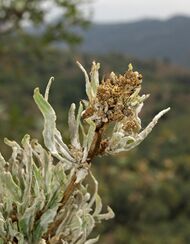Biology:Quercus pyrenaica
| Pyrenean oak | |
|---|---|

| |
| Scientific classification | |
| Kingdom: | Plantae |
| Clade: | Tracheophytes |
| Clade: | Angiosperms |
| Clade: | Eudicots |
| Clade: | Rosids |
| Order: | Fagales |
| Family: | Fagaceae |
| Genus: | Quercus |
| Subgenus: | Quercus subg. Quercus |
| Section: | Quercus sect. Quercus |
| Species: | Q. pyrenaica
|
| Binomial name | |
| Quercus pyrenaica Willd.
| |

| |
| Distribution map | |
| Synonyms [2] | |
|
List
| |
Quercus pyrenaica, also known as Pyrenean oak,[3] or Spanish oak[4] is a tree native to southwestern Europe and northwestern North Africa. Despite its common name, it is rarely found in the Pyrenees Mountains and is more abundant in northern Portugal and north and northwestern Spain.
It is placed in section Quercus.[5]
The oak is cultivated as an ornamental tree for gardens and parks.[1]
Description
Quercus pyrenaica is a tall deciduous tree, often marcescent in immature individuals,[6] up to 25 metres (80 feet) tall, though it is sometimes found as a bush or small tree. It has an average lifespan of 300 years.[7] The leaves have short petioles and are deeply and irregularly lobed, with four to eight pairs of lobes per leaf. There are stellate hairs on both sides of the leaf.[8] Roots frequently produce suckers. The species has high resprouting capabilities.[1]
Distribution and habitat
Quercus pyrenaica is native to the Iberian Peninsula and parts of southwest France and northern Morocco inhabiting mainly subatlantic or continental environments up to 2,100 m (6,900 ft) in elevation.[8] In the Iberian Peninsula, which represents 95% of its population,[1] it occupies mainly the northern portion, south of the Cantabrian Mountains, very common in the west of the Peninsula in the northern half of mountainous Portugal,[6] and rare on the east[8] It is adapted both to sub-humid temperate and Mediterranean semi-arid conditions, from the humid Peneda-Gerês National Park in Portugal, to the semi-arid Spanish central plain. It is also adapted to survive in hot local temperatures. It is thought to have a short growth season to avoid the summer drought.[1] It is often the dominant species in the forests in which it occurs.[7] Its acorns are dispersed by birds and small mammals.[7]
Threats
The species is currently threatened by wild fire which encourage the growth of other oak species that Q. pyrenaica is unable to compete with, and insect pathogens such as green oak leaf roller moth (Tortrix viridana), the gipsy moth (Lymantria dispar) and brown-tail moth (Euproctis chrysorrhoea); these threats may become of greater concern due to the impact of climate change.[1]
Historically the species experienced decline due to charcoal and timber industry, and forestry activities still pose some threat to Q. pyrenaica but on a much reduced scale.[1]
References
- ↑ 1.0 1.1 1.2 1.3 1.4 1.5 1.6 Gorener, V.; Harvey-Brown, Y.; Barstow, M. (2017). "Quercus pyrenaica". IUCN Red List of Threatened Species 2017: e.T78972170A78972188. doi:10.2305/IUCN.UK.2017-3.RLTS.T78972170A78972188.en. https://www.iucnredlist.org/species/78972170/78972188. Retrieved 19 November 2021.
- ↑ "Quercus pyrenaica Willd.". World Checklist of Selected Plant Families (WCSP). Royal Botanic Gardens (Kew). http://www.theplantlist.org/tpl1.1/record/kew-174637.
- ↑ (xls) BSBI List 2007, Botanical Society of Britain and Ireland, https://bsbi.org/download/3542/, retrieved 2014-10-17
- ↑ "Ageing in Spanish Oak". Bodegas LAN. https://bodegaslan.com/en/ageing-in-spanish-oak/.
- ↑ Denk, Thomas; Grimm, Guido W.; Manos, Paul S.; Deng, Min; Hipp, Andrew L. (2017-11-02) (xls), Appendix 2.1: An updated infrageneric classification of the oaks, doi:10.6084/m9.figshare.5547622.v1, https://figshare.com/articles/dataset/Appendix_2_1_________An_updated_infrageneric_classification_of_the_oaks/5547622/1, retrieved 2023-02-17
- ↑ 6.0 6.1 "Quercus pyrenaica Willd.". Flora-on. https://flora-on.pt/#/1quercus+pyrenaica.
- ↑ 7.0 7.1 7.2 Harvey-Brown, Y. (2017). "Quercus pyrenaica in Europe". IUCN Red List of Threatened Species 2017: e.T78972170A80570544. https://www.iucnredlist.org/species/78972170/80570544. Retrieved 22 January 2021.
- ↑ 8.0 8.1 8.2 "Quercus pyrenaica". Flora Iberica. http://www.floraiberica.es/floraiberica/texto/pdfs/02_041_03_Quercus.pdf.
External links
Wikidata ☰ Q899686 entry
 |








